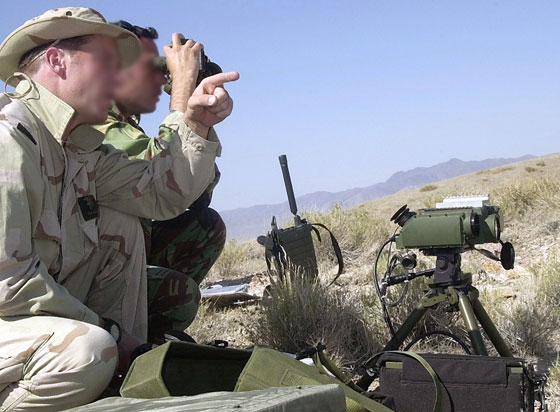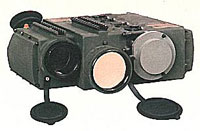LASER TARGET DESIGNATOR (LTD)
Laser designators are portable devices carried by UKSF and Forward Air Controllers (FAC) units for the purpose of marking targets for friendly air assets. Consisting of an optical sight, coded laser emitter and range finder, Laser Target Designators (LTD) vary in size but are usually mounted on tripods to ensure a stable aiming platform.
How Laser Target Designators work
An intensely focused beam of light is shone at a target. This is known as 'painting the target'. A sensor on an attacking aircraft's bomb or missile detects the laser beam as it bounces off the painted target. Upon release, the laser-guided munitions follows this aim point, effectively homing in on the beam's reflection. The laser beam is 'coded' which means it shines in specific patterns of pulses. This coding enables the air assets to ensure they are being guided by the correct designator. LTDs can effectively be used to paint targets for aircraft operating at medium to low level altitudes.

The role of LTDs in modern warfare

With the increasing accuracy of air power demonstrated in Gulf War I, many commentators speculated if the role of 'boots on the ground' would become much less important. The reality is that a partnership between special forces ground units and attack aircraft was soon forged. It was soon realized that, for certain missions, a pair of eyes on the ground would significantly enhance the precision and lethality of the air strikes. Properly equipped with a portable laser designator, a small special forces unit on the ground can visually confirm the target and adjust the aiming point to ensure a direct hit. This combination of air power and special forces on the ground enable truly surgical strikes. It's rumoured that, following the Al-Qaeda bombings of US Embassies in Africa, US SF trained for clandestine attacks on terrorist leadership, using a mixture of Special Operations forces and Naval F-18s armed with laser-guided bombs. The idea was to sneak into a suspected location of a Al-Qaeda leader, hide up, visually identify the target, then call in the jets to strike the building, vehicle or patch of ground occupied by the target. Such a mission is far less risky for the ground team that attempting to storm the location on foot and carries less risk of collateral damage than a 'blind' air strike. With laser-guided weapons now carried by fighter bombers, helicopter gunships and unmanned drones, there is more scope than ever for such missions.
Another role for LTDs in the ongoing war on terror, is to mark targets for close air support. UK Tactical Air Controllers have made extensive use of LTDs in Afghsnistan where they are used to clearly identify the target for coaltion strike aircraft.








